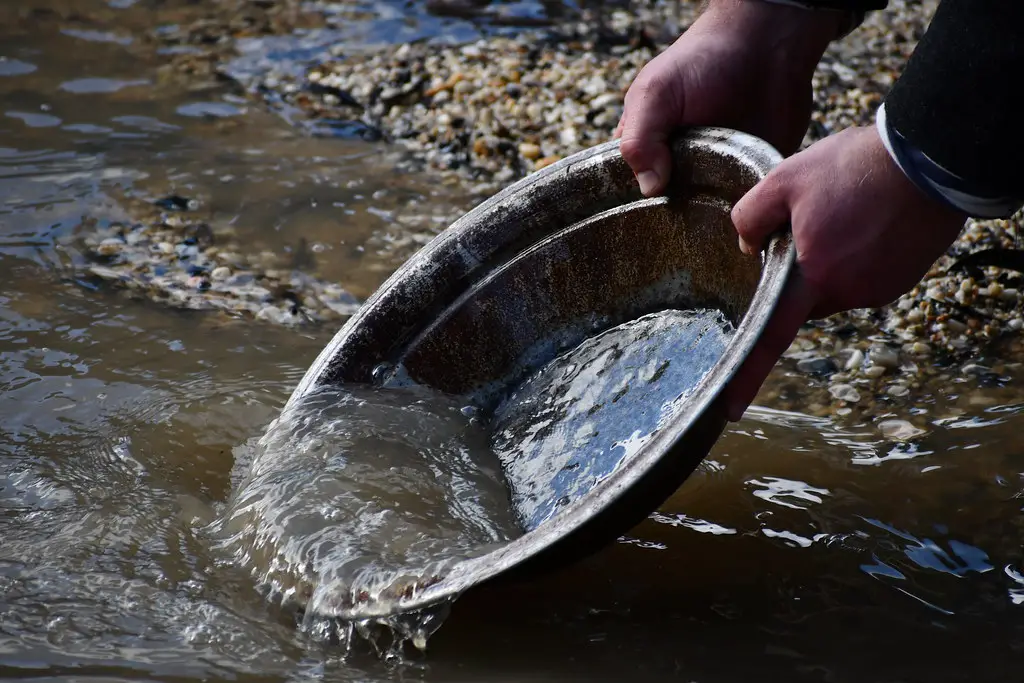
Mastering Gold Panning Techniques: Preparing the Pan
Before you begin your gold panning adventure, it’s important to properly prepare your pan to ensure effective gold recovery. Here are the key steps to follow:
Choosing the right pan size
When it comes to gold panning, size does matter. For average gold panners, it is recommended to use a “half-size” pan. This size provides a good balance between ease of use and efficiency. However, experienced panners may prefer larger pans for increased capacity.
Ensuring the pan is clean and free of grease
To prevent contaminants from interfering with your gold panning process, it’s crucial to make sure your pan is clean and free of any grease or oil residues. Grease can repel water and cause your gold to sink, making it harder to recover. Use warm water and dish soap to thoroughly clean your pan before each use.
Removing rust preventative with the burning process
Many gold pans are coated with a rust preventative substance for storage and shipping purposes. It’s important to remove this coating before using your pan. One effective method is the burning process. Simply build a small fire and place your pan, bottom side down, on the hot coals for a few minutes. The heat will burn off the rust preventative, leaving your pan clean and ready for use.
Suspension and Stratification
Understanding the concepts of suspension and stratification is crucial for maximizing your gold recovery. Here’s what you need to know:
Understanding the concept of suspension
Suspension refers to the process of keeping the heavier gold particles and lighter materials in a state of suspension within the pan. By swirling the water and material mixture, you create a vortex that allows the gold to stay suspended while the lighter materials are washed away.
Creating stratification for better gold recovery
Stratification involves arranging the materials within your pan in layers based on their specific gravity. The heaviest materials, including gold, will settle at the bottom of the pan, while the lighter materials will be on top. By gently shaking and swirling the pan, you can create these distinct layers, making it easier to separate the gold from the rest.
Learning the proper shaking techniques
The way you shake your pan can greatly affect your gold recovery. It’s important to strike a balance between too much and too little shaking. Agitating the pan too vigorously can cause the gold to be thrown out of the pan, while not shaking enough can result in incomplete separation. Practice different shaking techniques to find what works best for you.
Mastering Gold Panning Techniques: Washing the Pan
Once you have established suspension and stratification, it’s time to wash away the lighter materials and concentrate on the gold. Follow these steps for optimal results:
Adding water to the pan
Begin by adding water to the pan, filling it about two-thirds full. The water helps create the necessary agitation for separating the gold. Make sure to use clean water, free from any contaminating particles.
Gently swirling the water to wash away lighter material
With the water in the pan, gently tilt and swirl the pan back and forth in a circular motion. This movement allows the water to wash away the lighter materials, such as sand and gravel, while keeping the heavier gold particles in suspension.
Avoiding excessive agitation to prevent gold loss
While it’s important to create enough agitation to wash away the unwanted materials, it’s equally crucial to avoid excessive shaking. Agitating the pan too much can cause the gold particles to be displaced and lost from the pan. Find a balance between gentle swirling and controlled agitation to retain as much gold as possible.
Mastering Gold Panning Techniques: Cleaning the Gold Pan
Keeping your gold pan clean and free from residual material is essential for optimal performance. Follow these steps to properly clean your pan:
Properly disposing of concentrated material
Once you have finished washing the pan and the majority of the lighter materials have been removed, it’s important to properly dispose of the concentrated material. This concentrated material may contain leftover gold particles, so ensure you carefully collect and transfer it to a separate container for later inspection.
Removing remaining material with water
After disposing of the concentrated material, rinse the pan with clean water to remove any remaining residue. Use your hands or a scrub brush to gently remove any stubborn particles. Make sure to thoroughly clean both the inner and outer surfaces of the pan.
Drying and storing the pan for future use
Once your pan is clean, allow it to air dry completely. Avoid using heat sources like direct sunlight or a hairdryer, as these can damage the pan’s material. Once dry, store your pan in a safe and dry place, ready for your next gold panning adventure.
Inspecting the Pan and Estimating Gold Recovered
The final step in the gold panning process is inspecting your pan and estimating the amount of gold you have recovered. Follow these guidelines to evaluate your success:
Examining the concentrate for gold presence
Carefully examine the concentrated material you collected during the panning process. Look for any shiny, metallic flakes or particles that resemble gold. Use a bright light source or natural sunlight to enhance visibility.
Using a magnifying glass to spot tiny gold flakes
Sometimes, the gold particles can be extremely small and difficult to spot with the naked eye. In such cases, a magnifying glass can be a handy tool. Use a magnifying glass to closely examine the concentrate, enabling you to identify even the tiniest gold flakes.
Estimating the amount of gold recovered
While it’s challenging to determine the exact amount of gold recovered through visual inspection alone, you can make a rough estimate by comparing your findings to known quantities of gold. Keep in mind that your estimation may not be entirely accurate, but it can provide a general idea of your success rate.
Removing Gold from the Pan
Congratulations! You have successfully recovered gold from your pan. Now, it’s time to safely extract and collect it. Here’s what you need to do:
Using tweezers or a snuffer bottle to extract gold
To avoid losing any of the precious gold particles, use tweezers or a snuffer bottle to carefully pick them up from the concentrate. These tools allow for precise and controlled extraction, minimizing the risk of accidental loss.
Being careful not to lose any gold particles
Gold is extremely dense and heavy, making it prone to accidentally slipping away. Handle your gold particles with utmost care and ensure you have a secure grip to avoid losing any valuable pieces. Take your time and exercise patience during this delicate process.
Transferring the collected gold into a vial or container
Once you have safely extracted the gold particles, transfer them into a designated vial or container for safekeeping. Ensure the container is tightly sealed to prevent any loss or contamination. Label the container with the date and location of your gold panning adventure for future reference.
Choosing the Right Equipment
Selecting the appropriate gold panning equipment can greatly enhance your overall experience and success rate. Consider these factors when choosing your tools:
Exploring different types of gold pans
Gold pans come in various shapes, sizes, and materials. Explore different options to find a pan that suits your preferences and needs. Common materials include plastic, steel, and copper, each offering unique advantages and disadvantages.
Considering the benefits of using a perforated pan or sieve
A perforated pan or sieve can significantly speed up the panning process and improve working conditions. These tools allow the water to flow through easily, helping to wash away lighter materials and leaving behind the heavier gold particles.
Understanding the advantages of a safety pan
A safety pan is designed with raised sides and ridges, providing an extra layer of protection against accidental loss of your sample. This type of pan is highly recommended for beginners or individuals working in challenging environments with fast-flowing water.
Mastering the Shaking Technique
The way you shake your pan can greatly impact your gold recovery. Here are some tips to master the shaking technique:
Learning the correct way to shake the pan
Hold your pan firmly with both hands, ensuring a secure grip. Shake the pan in a back-and-forth motion while simultaneously tilting it slightly to create the necessary agitation. Experiment with different shaking patterns to find the motion that works best for you.
Applying the right amount of force
Finding the right amount of force to apply during shaking is crucial. Too much force can cause the gold to be thrown out of the pan, while too little force may not provide enough agitation for effective separation. Practice and adjust your shaking technique until you achieve a balance that yields maximum results.
Recognizing when to stop shaking
Knowing when to stop shaking is key to successful gold panning. As you shake the pan, pay attention to changes in the material and water movement. When the desired stratification and separation have been achieved, it’s time to stop shaking and move on to the next step. Trust your instincts and experience to make this judgment call.
Dealing with Heavy Black Sand
Heavy black sand can present challenges during the gold panning process. Here’s how to effectively deal with this issue:
Understanding the challenges of heavy black sand
Heavy black sand, often comprised of magnetite or other minerals, can be difficult to separate from gold. Its high density and magnetic properties can cause it to cling to the gold particles, making the recovery process more complex.
Implementing stage panning for efficient gold recovery
If you encounter a large amount of heavy black sand, stage panning can be a useful technique. Divide your material into smaller portions and pan each portion separately. This allows for more focused gold recovery and facilitates better separation from the black sand.
Using a magnet to remove magnetic black sands
To further aid in the removal of magnetic black sands, consider using a magnet. Pass the magnet over the concentrate or use it to attract the black sands out of the pan. Make sure to keep the magnet away from your gold particles to avoid any accidental loss.
Utilizing Instructional Videos
When learning the art of gold panning, there’s nothing quite like watching experienced prospectors demonstrate the techniques. Here’s how to make the most of instructional videos:
Finding reliable and informative gold panning videos
Search online platforms and resources for reliable and informative gold panning videos. Look for videos produced by reputable sources or experienced gold panners who have a proven track record. Reading reviews and seeking recommendations can help you find the best videos to learn from.
Watching experienced prospectors demonstrate techniques
Watch the videos carefully, paying close attention to the techniques and movements of experienced prospectors. Observe their shaking patterns, how they handle the pan, and their methods for extracting gold. Take notes and try to replicate their actions during your own gold panning adventures.
Learning from step-by-step video tutorials
Step-by-step video tutorials can be an invaluable resource for beginners. These tutorials guide you through the entire gold panning process, explaining each step in detail. Follow along with the video, pausing when necessary to practice the techniques yourself. By following the instructions closely, you can accelerate your learning process and become a proficient gold panner in no time. Here is a good channel to follow for more gold prospecting tips and techniques.
With this comprehensive guide to gold panning, you are well-equipped to embark on your own gold-hunting adventures. Remember, practice makes perfect, and each panning session presents an opportunity to refine your technique and improve your gold recovery. So grab your pan, head to the nearest gold-bearing stream, and enjoy the thrilling experience of uncovering nature’s treasure. Happy panning!
Read more about gold prospecting equipment here


